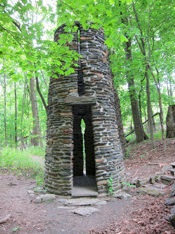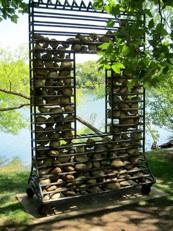sculpturehead






Sculpture Parks visited


Storm King
Mountainville, NY
Nathan Manilow
University Park, IL
The Fields at Omi
Ghent, NY
also


Socrates
Long Island City, NY
Sculpture Meadow, Kentuck Knob
Chalk Hill. PA
Grounds for Sculpture
Hamilton, NJ
Frederik Meijer Gardens & Sculpture Park
Grand Rapids, MI
Abington Art Center Sculpture Garden
Jenkintown, PA

Positive attributes


Artwork:
Powerful and interactive with surroundings
Site:
Attractive and varied landscape, but not overwrought
Space:
Scale should be related to work’s scale or have a meaningful dialogue with it
Location:
Works should be sited with some kind of purpose in their placement

NEGATIVe attributes


Artwork:
Merely plopped down in an empty space or, worse, framed by flowers
Site:
Too decorative. so that it competes with art; or just an unkempt weed field
Space:
Situating a sculpture just because there is an open space that needs filling
Location:
If either the artwork or the land take precedence over the other

favorites


Storm King
The Fields
Nathan Manilow
to-do list


Yorkshire Sculpture Park
Wakefield, UK
Laumeier Sculpture Park
St. Louis, MO
Olympic Sculpture Park
Seattle, WA
Forest of Dean Park Sculpture Trail
Gloucestershire, UK
De Cordova Sculpture Park
Lincoln, MA
Benini Foundation & Sculpture Ranch
Johnson City, TX
The Tree Museum
Muskoka, Ontario, CA
Wanas Foundation
Knislinge, Sweden
Fattoria di Celle
Pistoia, Italy


Sculpture Parks as Partners


Probasco Haus Press
Left: A Reclamation Garden, by Winifred Lutz, Abington Art Center, Abington, PA
Right: Passage, by Kevin Lyles, Grounds for Sculpture, Hamilton, NJ


Seeking the Relationship: Art to Site




Sculpture has always had to compete with painting in a gallery setting, sometimes used as filler for the empty space in the center of a room in which paintings lie flat against the walls. The arrival of sculpture parks has allowed the artwork not only to breathe out in nature, but also to live again where sculpture had once been – outside. Classically, sculpture was utilized as exterior adornment on building facades; as demarcations of space on processional walkways; as garden embellishment and reminders of human presence; as commemoration or markers of historic importance; or as portraiture. Sculpture as a stand-alone expression is a modern construct that reflects the artist’s mind and will more so than its functional past. In the latter half of the 20th century, sculpture returned outside, but this time on its own terms, to interact with the greater forces of nature – not just to capture and compete with it, but to relate to and coexist with it. It was a turning point, for sculpture and for large tracts of land, much of it former farm land or industrial sites. The result is a mutually beneficial pairing; and, in some cases, a new art form is being created – the irrevocable occurrence in this place with this art – a shared dynamic, a synergistic phenomenon.
The concept for sculpture parks found its genesis in Philadelphia (as did so many other things), beginning with the Fairmount Park Art Association (FPAA), founded in 1872, a group dedicated to integrating public art in and around the large and varied park lands as well as the urban setting. This same “city of firsts,” with the support of FPAA, later created the country’s first “percent for art” program in 1959. There were similar European programs for the incorporation and support of public art in cities and towns, but, in the U.S., Philadelphia was the first to go public, and it is now considered by many a “museum without walls.” Philadelphia and its park system are a sculpture park, the first example I ever saw. Sculpture parks and gardens, as well as percent-for-art urban programs, started to grow in the 1980s throughout the country.
Many of Fairmount Park’s early sculpture acquisitions are commemorative or historical, and much of the artwork in and around the park is placed decoratively. What I mean by that is that the work is not integrated with the site, it has no relationship to its context other than using it as a natural backdrop or pedestal. Rather, it is “prettily” situated as decorative garden statuary, instead of being there by necessity or having a meaningful dialogue with its surroundings. That can be pleasant, but this is a classical approach to sculpture, merely offering outdoor exhibition space or an enhancement of the designed grounds. The desired effect, for me, is for the experiential more so than display, a matter of pairing and not just placing. A museum without walls is a first step, and a good one, but the next and most satisfying step is the full integration and unimaginable separation of art and site, producing a powerful partnership.
As for percent-for-art, there was, early on, the tendency to deposit or plunk down a piece of art, often an abstract metal design, in the cavernous voids of office plazas – what Tom Wolfe called the “Turd on the Plaza.” The phrase ridiculed a kind of mindless concession to the public realm by calling these deposits “art placement” – when, in many cases, there was no interaction between the object and its site other than a monetary one. Public sculpture is a collaborative process involving many different stakeholders, and despite the attempt to create beauty and harmony, the result, sadly, can be compromise and resultant pap for the masses. So, with the emergence of sculpture parks providing art in a green setting arose a splendid notion, one that had the potential to improve the chances for enjoyment and enhancement by considered placement. Inappropriate siting, though, can exist even in sculpture parks, as much as it can in cityscapes. There is a need for another kind of descriptive (are you listening, Mr. Wolfe?) for the similar offense of plopping down bad sculpture, or bad spots for it, or a combination of both, not in cities but in parks. In such cases, let’s call them “rotting fruit,” or “turd on the green.”
Sculpture parks vary widely as meaningful venues for viewing works in their collections. The idea of sculpture parks is a lovely one – art together with nature, often cultivated nature. Just as not everyone should be an artist, not just anyone should be putting together sculpture collections for posterity. Money does not a great collection make, and unless the collection is exclusively about the artists’ names rather than the work, then the placement should be key. What is needed is a new art form – one that combines art and site to create something more special than the dropped-in-a-gallery mentality of display (which is really only merchandising) moved outdoors. It certainly seems to require multiple viewpoints and sets of eyes, but without the compromised failures of public art. Maybe sculpture parks need more talented folks to collaborate on placement rather than just installation. It might require the skills of both an artist and a landscape architect. Storm King achieves this integration and symbiosis more often than most other parks. (How does Storm King do it so well?) This website, and personal quest, is an attempt to point out examples that succeed in the pairing of art-to-site, with the hope that the idea catches on.



